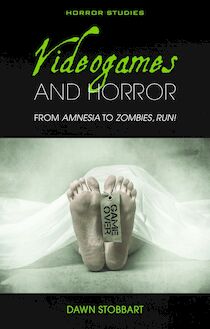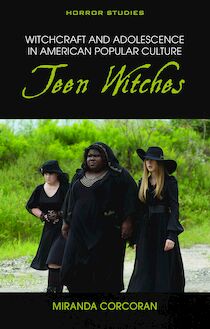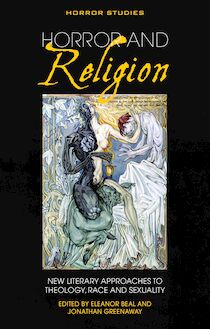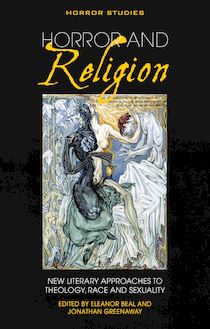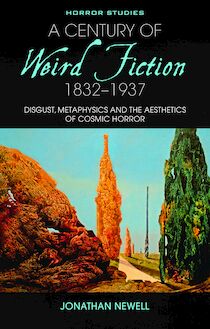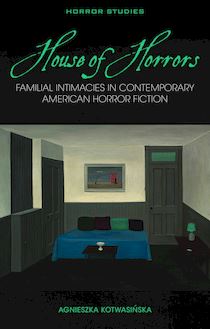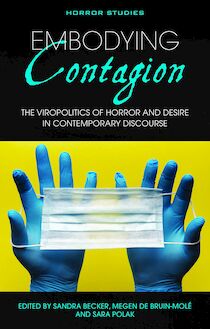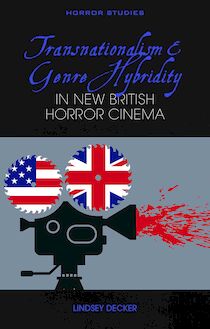-
 Univers
Univers
-
 Ebooks
Ebooks
-
 Livres audio
Livres audio
-
 Presse
Presse
-
 Podcasts
Podcasts
-
 BD
BD
-
 Documents
Documents
-
- Cours
- Révisions
- Ressources pédagogiques
- Sciences de l’éducation
- Manuels scolaires
- Langues
- Travaux de classe
- Annales de BEP
- Etudes supérieures
- Maternelle et primaire
- Fiches de lecture
- Orientation scolaire
- Méthodologie
- Corrigés de devoir
- Annales d’examens et concours
- Annales du bac
- Annales du brevet
- Rapports de stage
La lecture à portée de main
Vous pourrez modifier la taille du texte de cet ouvrage
Découvre YouScribe en t'inscrivant gratuitement
Je m'inscrisDécouvre YouScribe en t'inscrivant gratuitement
Je m'inscrisEn savoir plus
Vous pourrez modifier la taille du texte de cet ouvrage
En savoir plus

Description
The Horror genre has become one of the most popular genres of TV drama with the global success and fandom surrounding The Walking Dead, Supernatural and Stranger Things. Horror has always had a truly international reach, and nowhere is this more apparent than on television as explored in this provocative new collection looking at series from across the globe, and considering how Horror manifests in different cultural and broadcast/streaming contexts. Bringing together established scholars and new voices in the field, Global TV Horror examines historical and contemporary TV Horror from Australia, Brazil, Canada, Denmark, France, Iran, Japan, Spain, New Zealand, USA and the UK. It expands the discussion of TV Horror by offering fresh perspectives, examining new shows, and excavating new cultural histories, to render what has become so familiar – Horror on television – unfamiliar yet again.
Acknowledgments
Stacey Abbott and Lorna Jowett - Taking Over the Whole World: Global TV Horror, Then and Now
NATIONAL CONTEXTS
Simon Bacon - ‘Real’ Iranian Vampires: Television versus the Big Screen
Mark Fryers - ‘It’s not ghosts, it’s history’: The Sonic Tradition of British Horror Television
Rebecca Janicker - Terror Australis: The Wilderness Myth in TV’s Wolf Creek
Fernando Pagnoni Berns - Stories to Make You Think: The Horror of Daily Life under Francisco Franco’s Regime in Historias para No Dormir
Laura Cánepa, Leandro Caraça and Lúcio Reis-Filho - Sleep, little baby. Cuca is coming for you. Mom went to the field, and Dad is working too: the witch Cuca in the Brazilian folklore and television
FORMS AND AESTHETICS
Jonas Green - Beyond the Masochistic Pleasure Principle: The Subtle Gore of Les revenants.
Cat Lester - Giving Kids Goosebumps: Uncanny Aesthetics, Cyclic Structures and Anti-didacticism in Children's Horror Anthologies Series
Lorna Piatti-Farnell - As Raw as Flesh: Consuming Humans in TV Horror
INDUSTRY
Stella Gaynor - Driving Industrial Innovation: Fox International Channels and the Global Appeal of The Walking Dead
Andreas Halskov - Staking Claims or Sucking Up: Heartless, Nordic Twilight and the Cross-Pollination of Danish and American TV Drama
Charlotte Stevens - Video Game to Streaming Series: The Case of Castlevania on Netflix
James Rendell - Tracing Terror-Bytes: Ring: Saishusho as Japanese TV Horror, Online Transcultural J-Horror Fan Object, and Digital Only-Click Television
Conclusion - Transnationalism and TV Horror Fandom: A Conversation with Iain Robert Smith and Miranda Ruth Larsen
About the Contributors
Sujets
Informations
| Publié par | University of Wales Press |
| Date de parution | 01 mars 2021 |
| Nombre de lectures | 0 |
| EAN13 | 9781786836960 |
| Langue | English |
Informations légales : prix de location à la page 0,2850€. Cette information est donnée uniquement à titre indicatif conformément à la législation en vigueur.
Extrait
Global
TV HORROR
HORROR STUDIES
Series Editor
Xavier Aldana Reyes, Manchester Metropolitan University
Editorial Board
Stacey Abbott, Roehampton University
Linnie Blake, Manchester Metropolitan University
Harry M. Benshoff, University of North Texas
Fred Botting, Kingston University
Steven Bruhm, Western University
Steffen Hantke, Sogang University
Joan Hawkins, Indiana University
Agnieszka Soltysik Monnet, University of Lausanne
Bernice M. Murphy, Trinity College Dublin
Johnny Walker, Northumbria University
Preface
Horror Studies is the first book series exclusively dedicated to the study of the genre in its various manifestations – from fiction to cinema and television, magazines to comics, and extending to other forms of narrative texts such as video games and music. Horror Studies aims to raise the profile of Horror and to further its academic institutionalisation by providing a publishing home for cutting-edge research. As an exciting new venture within the established Cultural Studies and Literary Criticism programme, Horror Studies will expand the field in innovative and student-friendly ways.
Global
TV HORROR
EDITED BY STACEY ABBOTT AND LORNA JOWETT
© The Contributors, 2021
All rights reserved. No part of this book may be reproduced in any material form (including photocopying or storing it in any medium by electronic means and whether or not transiently or incidentally to some other use of this publication) without the written permission of the copyright owner except in accordance with the provisions of the Copyright, Designs and Patents Act. Applications for the copyright owner’s written permission to reproduce any part of this publication should be addressed to the University of Wales Press, University Registry, King Edward VII Avenue, Cardiff, CF10 3NS.
www.uwp.co.uk
British Library Cataloguing-in-Publication Data
A catalogue record for this book is available from the British Library.
ISBN: 978-1-78683-694-6
eISBN: 978-1-78683-696-0
The rights of The Contributors to be identified as authors of this work have been asserted in accordance with sections 77 and 79 of the Copyright, Designs and Patents Act 1988.
The publisher has no responsibility for the persistence or accuracy of URLs for any external or third-party internet websites referred to in this book, and does not guarantee that any content on such websites is, or will remain, accurate or appropriate.
Cover image © Shutterstock
Contents
Acknowledgements
Notes on Contributors
1. It’s Taking Over the Whole World
Global TV Horror, Then and Now
Stacey Abbott and Lorna Jowett
Part One: National Contexts
2. ‘Real’ Iranian Vampires
Television versus the Big Screen
Simon Bacon
3. ‘It’s Not Ghosts, It’s History’
The Sonic Tradition of British Horror Television
Mark Fryers
4. Terror Australis
The Wilderness Myth in TV’s Wolf Creek
Rebecca Janicker
5. Stories to Make You Think
The Horror of Daily Life under Francisco Franco’s Regime in Historias para No Dormir
Fernando Pagnoni Berns
6. Sleep, Little Baby. Cuca Is Coming for You. Mom Went to the Field, and Dad Is Working Too
The Witch Cuca in Brazilian Folklore and Television
Laura Cánepa, Leandro Caraça and Lúcio Reis-Filho
Part Two: Forms and Aesthetics
7. Beyond the Masochist Pleasure Principle
The Subtle Gore of Les revenants
Jonas Green
8. Giving Kids Goosebumps
Uncanny Aesthetics, Cyclic Structures and Anti-didacticism in Children’s Horror Anthologies
Catherine Lester
9. As Raw As Flesh
Consuming Humans in TV Horror
Lorna Piatti-Farnell
Part Three: Industry
10. Driving Industrial Innovation
FOX International Channels and the Global Appeal of The Walking Dead
Stella Gaynor
11. Staking Claims or Sucking Up
Heartless , Nordic Twilight and the Cross-pollination of Danish and American TV Drama
Andreas Halskov
12. Video Game to Streaming Series
The Case of Castlevania on Netflix
E. Charlotte Stevens
13. Tracing Terror-Bytes
Ring: Saishusho as Japanese TV Horror, Online Transcultural J-Horror Fan Object and Digital Only-click Television
James Rendell
Conclusion: Transnationalism and TV Horror Fandom
A Conversation with Iain Robert Smith and Miranda Ruth Larsen
Stacey Abbott and Lorna Jowett
Notes/Works Cited
Acknowledgements
E DITED COLLECTIONS such as this book are a rewarding collaboration between the editors and their authors, and so our first thank you goes to our contributors, whose professionalism and passion for TV horror underpin the value of this book. They have been a pleasure to work with and a constant reminder that fans of horror are the nicest people. We would like to express our gratitude to Xavier Aldana Reyes for his enthusiasm for the project and its inclusion in the Horror Studies series (UWP). Thank you to Sarah Lewis at the University of Wales Press for her hard work and support, and to everyone at UWP for their help in making this book happen. Thank you to the anonymous peer reviewer for their insightful feedback.
Stacey would like to thank her family in Canada for their encouragement and indulgence of her horror and Gothic passions. Thank you to her husband and partner-in-crime Simon Brown for his never-ending support and shared loved of horror. Most importantly she would like to thank her co-editor Lorna Jowett for being an outstanding collaborator and for making the hard work of writing and editing so much fun. This conversation started about their shared enthusiasm for Near Dark and vampires at a conference many, many years ago, and it continues through every project they undertake. Long may the conversation continue – ‘Let’s go to work.’
Lorna would like to think all the friends, family and colleagues who have supported her, especially in the last few, rather trying, years. A massive shout out is also due to Stacey Abbott, fantastic co-conspirator and all-round Champion. Long may the conversation continue – ‘I wish to do more violence.’
Notes on Contributors
Stacey Abbott is a Reader in Film and Television Studies at the University of Roehampton. Her main areas of research are Gothic and horror film and television, with a particular focus on the evolving mythologies of screen monsters. She has written extensively on Buffy the Vampire Slayer , Angel and Supernatural , as well as editing The Cult TV Book (2010). She is the author of Celluloid Vampires (2007), Angel: TV Milestone (2009), Undead Apocalypse: Vampires and Zombies in the 21st Century (2016) and the BFI Classic on Near Dark (2020). She is the co-author, with Lorna Jowett, of TV Horror: Investigating the Dark Side of the Small Screen (2013) and co-edited, with Jowett and Michael Starr, a special issue of Horror Studies examining the vampire on television. She is now immersed in a new project on horror and animation.
Simon Bacon is an independent scholar based in Poznań, Poland. He has edited books on various subjects including Gothic: A Reader (2018), Horror: A Companion (2019), and Monsters: A Companion (forthcoming). He has published monographs on, Becoming Vampire: Difference and the Vampire in Popular Culture (2016), Dracula as Absolute Other: The Troubling and Distracting Specter of Stoker’s Vampire on Screen (2019), Eco-Vampires: The Vampire as Environmentalist and Undead Eco-activist (2020), and is currently working on Invasion of Vampires from Another World: The Cinematic Alien Progeny of War of the Worlds and Dracula .
Fernando Gabriel Pagnoni Berns (PhD student) works as Professor at the Universidad de Buenos Aires (UBA), Facultad de Filosofía y Letras (Argentina). He teaches courses on international horror film. He is director of ‘Grite’, the research group on horror cinema, and has published chapters in the books To See the Saw Movies: Essays on Torture Porn and Post-9/11 Horror , edited by John Wallis, Critical Insights: Alfred Hitchcock , edited by Douglas Cunningham, Dreamscapes in Italian Cinema , edited by Francesco Pascuzzi, Reading Richard Matheson: A Critical Survey , edited by Cheyenne Mathews, Gender and Environment in Science Fiction , edited by Christy Tidwell, The Films of Delmer Daves , edited by Matthew Carter and Doubles and Hybrids in Latin American Gothic , edited by Antonio Alcalá (Routledge), among others. He has authored a book about Spanish horror TV series Historias para no Dormir (Universidad de Cádiz, 2020) and has edited a book on the Frankenstein bicentennial. He is currently editing a book on director James Wan and another on the Italian giallo film.
Laura Loguercio Cánepa , PhD in Multimedia (Unicamp, Brazil, 2008), is Professor on the Post-Graduate Programme in Communication at Anhembi Morumbi University (Brazil) since 2009 and Visiting Research Fellow at the University of Leeds (2019). She has published several works on Brazilian horror films, including ‘Erotic Brazilian Movies of Female Killers’ (in E Pornô, Tem Pornô? A Panorama of Brazilan Porn , edited by Mariana Baltar in 2018); ‘José Mojica Marins versus Coffin Joe: Auteurism and Stardom in Brazilian Cinema’, in Stars and Stardom in Brazilian Cinema , edited by Tom Bergfelder, Lisa Shaw and João Luiz Vieira, 2017); ‘Panorama histórico del horror en el cine brasileño (in Horrofílmico – Aproximaciones al cine de terror en Latinoamérica y el Caribe , edited by Rosana Díaz Zambrana e Patricia Tome, 2012).
Leandro Cesar Caraça , Master of Science in Multimedia at Universidade Estadual de Campinas (Brazil). is a film historian. His Master’s dissertation addressed the topic of Brazilian films of the 1950s. His current reasearch investigates Brazilian exploitation films.
Mark Fryers . Since submitting his PhD on British film, television and cultural history, Dr Mark Fryers has published numerous articles and chapters on film and television scholarship including in the Journal of Popular Television and on such topics as the British costume drama, British maritime film and television, on Jaws
-
 Univers
Univers
-
 Ebooks
Ebooks
-
 Livres audio
Livres audio
-
 Presse
Presse
-
 Podcasts
Podcasts
-
 BD
BD
-
 Documents
Documents
-
Jeunesse
-
Littérature
-
Ressources professionnelles
-
Santé et bien-être
-
Savoirs
-
Education
-
Loisirs et hobbies
-
Art, musique et cinéma
-
Actualité et débat de société
-
Jeunesse
-
Littérature
-
Ressources professionnelles
-
Santé et bien-être
-
Savoirs
-
Education
-
Loisirs et hobbies
-
Art, musique et cinéma
-
Actualité et débat de société
-
Actualités
-
Lifestyle
-
Presse jeunesse
-
Presse professionnelle
-
Pratique
-
Presse sportive
-
Presse internationale
-
Culture & Médias
-
Action et Aventures
-
Science-fiction et Fantasy
-
Société
-
Jeunesse
-
Littérature
-
Ressources professionnelles
-
Santé et bien-être
-
Savoirs
-
Education
-
Loisirs et hobbies
-
Art, musique et cinéma
-
Actualité et débat de société
- Cours
- Révisions
- Ressources pédagogiques
- Sciences de l’éducation
- Manuels scolaires
- Langues
- Travaux de classe
- Annales de BEP
- Etudes supérieures
- Maternelle et primaire
- Fiches de lecture
- Orientation scolaire
- Méthodologie
- Corrigés de devoir
- Annales d’examens et concours
- Annales du bac
- Annales du brevet
- Rapports de stage

